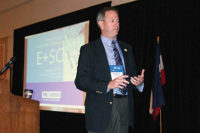A refrigeration contractor should surely know that the supermarket and restaurant sector is relying more and more on refrigeration — it’s only ‘natural.’
With so much emphasis being placed on consumable products labeled ‘natural’ or ‘organic’ these days, little, if any, preservatives or chemicals are used. They are either put on ice or in refrigerated cases until they are sold.
This was evident at the 2014 Food Marketing Institute (FMI) Connect event, which drew hundreds of exhibitors to Chicago for a two-day trade show bookended by business-related seminars and presentations. The event, which the FMI is now calling its expo, showcased some of the newest products that those who work in the food sector will more than likely see on a future install or service call.
New Refrigerants
The use of propane, or R-290, as a stand-alone refrigerant was a focus of Hillphoenix’s booth. Signage drew attention to a cooler running solely on R-290. The unit kept bottles of water cool, which were handed out to attendees. The equipment boasted a 150-gram charge, the most currently allowed by the U.S. Environmental Protection Agency (EPA), said Jules Choueifati, Hillphoenix’s manager of research and development.
Choueifati noted refrigeration equipment manufacturers promoting propane are looking to the EPA to allow larger charges so larger cooling units can be installed in businesses.
A case study featuring the H.E. Butt Grocery Co.’s use of R-290 within one of its 350 supermarket locations throughout Texas provided a specific example of the refrigerant in use.
Likewise, the exhibit booth of AHT Cooling Systems GmbH shared information on its reach-in plug-and-run coolers and freezers that were made in Austria and utilize R-290 natural propane gas in select models.
Right next to the R-290 cooler in the Hillphoenix booth was another new direction in refrigerants — the use of CO2 (R-744) as the sole refrigerant in a transcritical system. The approach eliminates the need for use of a second refrigerant such as hydrofluorocarbons (HFCs) or ammonia.
Transcritical CO2, also known as TC CO2, also was the focus of Parker Hannifin Corp.’s booth, with its Micro Thermal technologies and products for that approach. “Transcritical CO2 systems are desirable because they use no HFC refrigerants,” according to a statement issued by the company. “They also have good heat rejection, which is captured and reused for space and water heating and overall lower cost of ownership due to lower energy and refrigerant costs.”
Signage at the Parker booth also drew attention to new products from the company under the title Smart Service Techs. The rollout included wireless low- and high-pressure gauges that replace traditional manifold gauges; wireless temperature sensor clamps for quick and easy installation; and free iPhone and iPad apps. The approach records all data, displays suction temperatures and pressures, displays liquid pressures and temperatures, and calculates superheat and subcooling.
More Technologies
Beyond the long-standing direct expansion (DX) systems, supermarket equipment makers were continuing to note improvements in secondary loop and distributed approaches. Hussmann Corp. exhibited what it bills as its “ultimate green solution,” a micro-distributed refrigeration system that allows for a low refrigerant charge, excellent energy efficiencies in all climates, and “ease of install, service, and maintenance.”
Dan Wesner, Hussmann’s director of product portfolio, said that one innovation was keeping the mechanicals within each of the display cases. Previously, a common approach to distributed refrigeration was to have a small island of mechanicals serving a number of nearby cases. The new approach does away with that concept, freeing up more floor space for products. Wesner said micro-distributed refrigeration is critically charged by the manufacturer, so installation deals primarily with electrical and water drain line connections.
Cool-Fit™ is a piping technology from Georg Fischer Piping Systems for secondary and indirect refrigeration systems. Those approaches to creating cooling for food came about to reduce chlorofluorocarbon (CFC), hydrochlorofluorocarbon (HCFC), and HFC refrigerant charges. The secondary loop allowed for a second non-CFC, non-HCFC, or non-HFC liquid to be used in the cooling cycle. The mechanicals were placed closer to coolers and freezers resulting in multiple smaller mechanicals rather than one large system, as was the case with DX systems. With the theoretical ability to do that came the need for components to work with the newer approaches, thus the Georg Fischer display.
It’s All About the Look
Another consideration, especially at a show that draws store owners who have purchasing power, was equipment that focuses on aesthetics. For example, a Crystal™ merchandiser from Zero Zone Inc. had a 74-inch reach-in door that encompassed almost the entire front of the cooler to show product. The mechanicals were designed for energy savings and for less product shrink.
Publication date: 9/8/2014
Want more HVAC industry news and information? Join The NEWS on Facebook, Twitter, and LinkedIn today!










